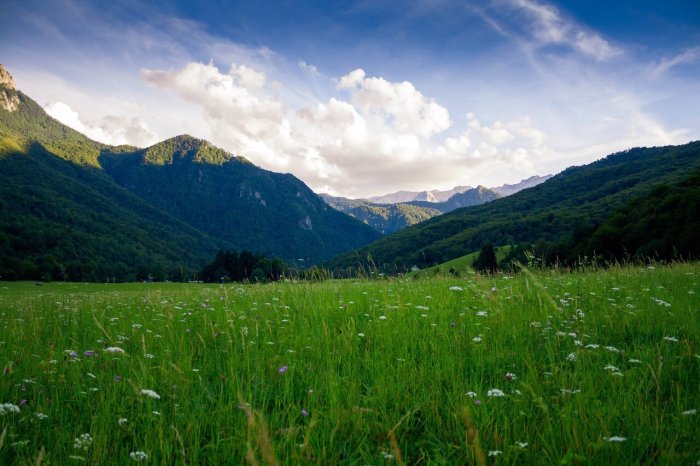Where do the locals go in Istanbul? This exploration dives deep into the hidden gems and everyday routines of Istanbul’s residents, revealing the vibrant tapestry of experiences beyond the tourist trail. From bustling local markets to hidden cafes, we’ll uncover the neighborhoods, food stalls, and entertainment spots that locals cherish.
This journey delves into the unique cultural aspects that shape the local experience, providing a contrast to the tourist-focused areas. We’ll explore how locals navigate their city, uncover their culinary preferences, and understand the local traditions that define their daily lives. The result is a comprehensive look at the authentic Istanbul, beyond the typical tourist hotspots.
Local Experiences in Istanbul
Istanbul, a city steeped in history and vibrant culture, offers more than just iconic landmarks. Beyond the tourist hotspots, a wealth of local experiences await those willing to venture beyond the well-trodden paths. These experiences provide a deeper understanding of the city’s soul, allowing visitors to connect with the daily lives and passions of its residents.
Local Food Scene
Istanbul’s culinary scene is a kaleidoscope of flavors, reflecting its diverse history and cultural influences. Beyond the popular tourist restaurants, a plethora of local eateries serve up authentic Turkish cuisine, often at significantly lower prices. These establishments often focus on traditional recipes, using fresh, seasonal ingredients, and offering a glimpse into the daily culinary habits of Istanbul’s residents.
- Lokantas: These traditional Turkish restaurants are typically family-run businesses, serving up hearty portions of dishes like kıymalı pide (minced meat pie), köfte (meatballs), and lahmacun (Turkish pizza). They often feature a lively atmosphere, reflecting the warmth of Turkish hospitality.
- Street Food Stalls: From sizzling döner to flavorful simit (sesame-studded bread) and fragrant borek (savory pastries), Istanbul’s street food scene is a testament to the city’s vibrant energy. These stalls provide a casual and affordable way to sample local delicacies.
- Neighborhood Bakeries: Many neighborhood bakeries are local favorites, serving up freshly baked pastries, breads, and cakes. These are often frequented by locals, providing a taste of daily life and showcasing the skill of local bakers.
Local Shopping Experiences
Istanbul’s bustling markets offer a rich tapestry of local crafts and goods. Beyond the large tourist-oriented bazaars, smaller, more intimate shops and markets cater specifically to the tastes of local shoppers. These hidden gems often offer unique souvenirs, handmade items, and locally produced goods, showcasing the skills and creativity of local artisans.
- Neighborhood Markets: These smaller markets often focus on fresh produce, local crafts, and everyday goods. They provide a glimpse into the local community’s daily needs and shopping habits.
- Independent Boutiques: In neighborhoods like Beyoğlu and Kadıköy, independent boutiques and clothing stores cater to local fashion trends. These shops are often run by local designers or entrepreneurs, showcasing the unique style and tastes of the city.
- Craft Workshops: Numerous workshops throughout the city allow visitors to observe and participate in the creation of local crafts, from ceramics to jewelry to textiles. This hands-on experience offers a unique connection with local artisans.
Entertainment and Cultural Experiences
Beyond the well-known tourist attractions, Istanbul’s local entertainment scene offers a variety of experiences. Local music venues, theater performances, and cultural events are often overlooked by tourists, but they provide a rich understanding of Istanbul’s vibrant artistic scene.
- Neighborhood Cafés and Bars: Many neighborhood cafes and bars are popular gathering places for locals. These establishments often host live music, poetry readings, or other cultural events, offering a sense of community and entertainment.
- Local Theaters and Music Venues: Istanbul boasts a vibrant theatrical and musical scene. Smaller theaters and venues often host performances in Turkish, providing a deeper cultural immersion for those who understand the language.
- Neighborhood Festivals and Events: Many neighborhoods host local festivals and events, offering opportunities to experience local traditions, music, and cuisine. These are often open to the public and provide a sense of the local community’s celebrations.
Comparing Local and Tourist Experiences
| Location | Type | Description | Target Audience |
|---|---|---|---|
| Spice Market (Egyptian Bazaar) | Shopping | Large bazaar, offering a wide array of spices, teas, and other goods. | Tourists and locals. |
| Small neighborhood bakery | Food | Local bakery serving traditional Turkish pastries and bread. | Locals and tourists seeking authentic Turkish pastries. |
| Historic Grand Bazaar | Shopping | Large covered market with numerous shops. | Primarily tourists |
| Neighborhood cafe | Entertainment | Cafe with live music or other cultural performances. | Locals and tourists seeking a local experience. |
Neighborhood Exploration
Istanbul’s neighborhoods offer a fascinating glimpse into the city’s vibrant soul, far beyond the tourist hotspots. These local areas reveal the true rhythm of daily life, the hidden gems, and the unique character that makes Istanbul so captivating. Exploring beyond the well-trodden paths allows for a deeper connection with the city and its people.
Popular Local Neighborhoods
These neighborhoods, favored by Istanbul’s residents, offer a distinct experience compared to the tourist-heavy areas. They are characterized by a more relaxed atmosphere, local businesses, and authentic interactions. Their charm lies in their unpretentious nature and the genuine warmth of their residents. Examples include the bustling markets, traditional eateries, and the vibrant social life that flourishes in these neighborhoods.
Characteristics Differentiating Local Neighborhoods
The neighborhoods frequented by locals often exhibit unique characteristics that set them apart from tourist zones. These differences include a greater concentration of local businesses, a slower pace of life, and a noticeably less tourist-oriented environment. This translates to a more authentic experience for visitors. The absence of large tour groups and the presence of daily routines contribute to a richer and more immersive experience.
For instance, the local interactions are often more spontaneous and unfiltered.
Daily Routines and Activities
Locals in these neighborhoods lead lives centered around their immediate surroundings. Morning routines often involve visits to local markets for fresh produce and daily necessities. Afternoon activities can involve family gatherings, socializing with neighbors, or engaging in local crafts. Evening routines can include family dinners at local eateries or engaging in community events. This close-knit community fosters a sense of belonging and a strong connection to the neighborhood.
Local Shops and Eateries
These neighborhoods are filled with local favorites, offering an authentic taste of Istanbul. These shops and eateries are often family-run businesses, providing a unique connection to the neighborhood’s history and traditions. For example, the neighborhood bakers often sell their homemade bread and pastries, and traditional Turkish coffee houses are a hub for locals.
- Spice Shops: These often have a vast array of unique spices and herbs used in traditional Turkish cuisine, with a direct connection to the region’s rich culinary history.
- Neighborhood Bakeries: These provide fresh bread and pastries, reflecting the local culinary tradition, often with unique recipes passed down through generations.
- Traditional Turkish Coffee Houses: These are social hubs, offering a chance to experience the local culture and traditions. They are often the center of neighborhood interactions.
Neighborhood Characteristics
| Neighborhood | Vibe | Typical Activities | Local Favorites |
|---|---|---|---|
| Balat | Charming, historic, artistic | Strolling through the narrow streets, visiting art galleries, enjoying Turkish coffee | Local bakeries, traditional Turkish coffee houses, art galleries |
| Fener | Vibrant, cultural, bustling | Visiting local markets, engaging in cultural activities, attending neighborhood events | Local markets, traditional Turkish restaurants, artisan workshops |
| Sultanahmet | Historic, religious, tourist-heavy | Visiting historical sites, experiencing religious sites, participating in local markets | Local spice shops, traditional Turkish cafes, historical sites |
Food and Drink
Istanbul’s culinary scene is a vibrant tapestry woven from centuries of history and diverse influences. From the bustling spice markets to the intimate, family-run restaurants, the city offers a delectable journey for every palate. Locals prioritize fresh, seasonal ingredients and traditional techniques, creating a unique dining experience distinct from the tourist hotspots. This exploration delves into the heart of local culinary traditions, revealing the nuances of Istanbul’s food culture.The local dining preferences often revolve around affordable and authentic experiences.
This contrasts sharply with the more expensive, often tourist-oriented restaurants that cater to a broader range of tastes and budgets. Locals favor places where they can savor familiar dishes prepared with quality ingredients, often in relaxed, unpretentious settings.
Local Eateries with Unique Dishes
Istanbul boasts a plethora of eateries offering unique dishes. These establishments often showcase traditional recipes passed down through generations, providing a glimpse into the city’s rich culinary heritage.
- Lokantas: These family-run restaurants are often the heart of local communities. They offer classic Turkish dishes like kofte (meatballs), pide (Turkish flatbread), and zeytinyağlılar (vegetables cooked in olive oil). The atmosphere is generally informal, and the prices are extremely reasonable. They are a true reflection of local preferences, where the focus is on quality ingredients and home-style cooking.
Istanbul locals love a good, old-fashioned market spree! Spice markets and bustling bazaars are their go-to spots. But, if you’re looking for something a little different, check out the unique experiences offered in Western Australia, like easter bunny travel western australia , which might offer some unexpected treats and local adventures. Ultimately, the best way to experience Istanbul is to soak in its diverse atmosphere and discover your own hidden gems!
- Street Food Stalls: From simit (sesame bagels) to köfte (meatballs) to döner (gyro-style meat), Istanbul’s street food scene is a testament to the city’s vibrant energy. These small stalls offer a quick and affordable taste of local favorites, often prepared with fresh ingredients and seasoned to perfection. The street food is a popular choice among locals, especially during breakfast or as a quick snack.
- Spice Markets: A visit to a spice market like the Egyptian Bazaar or the Spice Bazaar is a sensory experience in itself. These bustling markets are a feast for the eyes and the nose, overflowing with colorful spices, herbs, and dried fruits. Locals often visit these markets to stock up on ingredients for home cooking, demonstrating the importance of fresh spices in Turkish cuisine.
History and Evolution of Local Food Preferences
Turkish cuisine has been shaped by centuries of interactions with neighboring cultures. The Ottoman Empire’s vast territories brought a diverse array of culinary traditions to Istanbul, influencing local tastes and creating a rich tapestry of flavors. Over time, these influences have melded to create a unique identity.
- Ottoman Influence: The Ottoman Empire’s influence on Turkish cuisine is profound. Dishes like dolma (stuffed vegetables) and baklava (layered pastry) are examples of dishes that have deep roots in Ottoman culinary traditions.
- Modern Adaptations: Istanbul’s food scene continues to evolve. Modern interpretations of traditional dishes and the incorporation of global flavors demonstrate the city’s dynamic nature. This fusion of traditional and modern approaches keeps the food scene exciting and appealing to a broad audience.
Comparison of Local and Tourist Dining Options
Local dining often contrasts sharply with the more expensive and tourist-oriented restaurants. The former often prioritizes authenticity, affordability, and the local experience, while the latter often caters to broader tastes and budgets.
Istanbul’s a whirlwind of hidden gems, and figuring out where the locals actually hang out is key to experiencing the city authentically. Instead of just hitting the tourist traps, you should seek out the local eateries and cafes, like those tucked away in the Sultanahmet neighborhood. To really immerse yourself in a place, learning how the locals experience it is vital.
For example, check out this guide on how to explore Norway like a Norwegian to see how it’s done in another beautiful country. how to explore norway like a norwegian It’s all about finding those unique spots where the locals gather, and you’ll be rewarded with a deeper understanding of the city’s soul, and hopefully, a great Istanbul experience.
| Feature | Local Dining | Tourist Dining |
|---|---|---|
| Price | Generally affordable | Often higher |
| Atmosphere | Informal and relaxed | Can be more formal |
| Menu | Focuses on traditional Turkish dishes | Offers a wider range of international cuisines |
| Experience | Immersive into local culture | More focused on a tourist experience |
Shopping and Markets
Istanbul’s vibrant markets offer a captivating glimpse into the city’s soul, far beyond the tourist-centric shops. These bustling hubs are where locals shop, haggle, and connect with the city’s rich history and traditions. From the spice-laden aromas of the Grand Bazaar to the hidden gems of smaller neighborhood markets, exploring these spaces reveals a different side of Istanbul.Delving into the local markets reveals a unique shopping experience that contrasts sharply with the more structured and often pre-priced items found in tourist shops.
The local markets are a symphony of sights, sounds, and smells; a sensory experience that immerses you in the everyday lives of Istanbul residents. This immersion is often missed by tourists focused on pre-determined itineraries.
Local Markets and Shops
Istanbul’s residents frequent a diverse array of markets, each with its own character and specialty. These markets offer a rich tapestry of local products and experiences, a far cry from the often-sanitized environment of tourist-oriented shops.
- The Grand Bazaar (Kapalı Çarşı): A sprawling complex of shops, this historic market is a labyrinthine maze of stalls selling everything from textiles and spices to jewelry and antiques. The sheer scale and variety make it a captivating exploration, offering a tangible connection to Istanbul’s past.
- Egyptian Bazaar (Mısır Çarşısı): This market, known for its abundance of spices, dried fruits, and nuts, offers a rich sensory experience. The strong aromas and the vibrant colors create a truly immersive atmosphere.
- Balat Market: This neighborhood market is a hub for local residents, offering fresh produce, local cheeses, and a selection of Turkish treats. The atmosphere is more intimate and less overwhelming than the Grand Bazaar, allowing for a more relaxed shopping experience.
- Neighborhood Spice Shops: Many smaller, neighborhood spice shops are cornerstones of local life, offering high-quality spices and herbs. These shops are often family-run and provide an intimate experience with the vendors, allowing for personalized recommendations.
Shopping Habits and Preferences
Local shopping habits in Istanbul often revolve around direct interaction with vendors. Bargaining is a common practice, and building relationships with shopkeepers is encouraged. This is not about dishonesty, but about recognizing a reciprocal exchange. Locals appreciate quality and value, often prioritizing items made with traditional methods or sourced from local producers.
Comparison with Tourist-Oriented Shops
Tourist-oriented shops, while often visually appealing, frequently prioritize pre-set prices and standardized products to cater to a larger customer base. Local markets, on the other hand, offer a unique opportunity to engage with the city’s culture and discover hidden treasures. The experience often involves a personal connection with the vendor, adding a layer of authenticity to the purchase. The experience is far more intimate and rewarding, and while sometimes involving a haggle, the outcome often outweighs the effort.
Istanbul’s locals, you know, have their own secret spots. They often head to quieter, more authentic neighborhoods beyond the tourist traps. Thinking about a getaway? Consider something like the amazing hotels, resorts, and beach hotels, like the SoHo House or the first Caribbean property on Canouan, hotels resorts beach hotels soho house first caribbean property canouan.
These destinations are a world away, yet still provide a taste of relaxation and escape. But for the local experience, it’s about discovering the hidden gems of Istanbul, away from the main crowds.
Local Market Experience Table
| Market Name | Location | Speciality | Local Experience |
|---|---|---|---|
| Grand Bazaar | Sultanahmet | Textiles, spices, jewelry, antiques | A labyrinthine experience with a vast selection, encouraging bargaining. |
| Egyptian Bazaar | Sultanahmet | Spices, dried fruits, nuts | A sensory experience with a strong aroma and vibrant colors. |
| Balat Market | Balat | Fresh produce, cheeses, Turkish treats | An intimate atmosphere, offering fresh local goods. |
| Neighborhood Spice Shops | Various neighborhoods | High-quality spices, herbs | An intimate experience with personalized recommendations. |
Entertainment and Leisure
Istanbul’s vibrant energy extends beyond its historical sites and culinary delights. Locals discover joy in a multitude of leisure activities, reflecting the city’s diverse tapestry. From intimate gatherings in cozy cafes to lively celebrations at local events, Istanbul offers a unique blend of entertainment tailored to its residents.Beyond the tourist hotspots, Istanbul offers a different perspective on entertainment.
Locals often prioritize experiences that foster connection and community, appreciating the simple pleasures of a shared meal or a leisurely stroll through a park. Understanding these local preferences allows for a deeper appreciation of the city’s true character.
Local Entertainment Preferences
Istanbul’s locals enjoy a range of entertainment options, often prioritizing those that offer social interaction and cultural immersion. Cafes are more than just places to grab a drink; they’re hubs for conversations, friendships, and community building. Similarly, parks serve as vital spaces for relaxation, social gatherings, and family time.
Parks and Outdoor Spaces, Where do the locals go in istanbul
Istanbul boasts numerous parks, each with its own charm and character. Locals frequently visit these spaces for picnics, leisurely walks, and social gatherings. Yıldız Park, with its expansive lawns and historical significance, attracts families and couples. Emirgan Park, with its stunning views of the Bosphorus, provides a serene escape from the city’s hustle. These parks are more than just green spaces; they’re integral parts of Istanbul’s social fabric.
Local families and friends often gather in these areas to enjoy the outdoors, play games, and spend quality time together.
Cafes and Social Interaction
Cafes are crucial social hubs for locals. They’re not just places to consume coffee or tea; they’re venues for socializing, catching up with friends, and engaging in lively conversations. The atmosphere of a traditional Turkish café, with its aroma of coffee and the murmur of conversations, fosters a sense of community. Local cafes often host live music or poetry readings, enriching the social experience.
The casual atmosphere allows for relaxed interaction and a deep sense of belonging.
Cultural Events and Festivals
Istanbul’s cultural calendar is packed with events, festivals, and performances that appeal to locals. Neighborhood festivals, often focused on local traditions and cuisine, bring communities together. Live music venues and theatres host a range of performances, from traditional Turkish music to contemporary art exhibitions. These events offer a glimpse into Istanbul’s rich cultural heritage and provide opportunities for residents to experience something new together.
Local Event Examples
- Neighborhood Festivals: These often focus on local traditions, cuisine, and celebrations. They are opportunities for families and friends to connect over food, music, and entertainment.
- Live Music Performances: Many cafes and venues host live music, providing a social setting for locals to enjoy traditional Turkish music, folk music, or contemporary genres.
- Art Exhibitions and Performances: Istanbul has a vibrant art scene, with numerous galleries and performance spaces showcasing local and international artists.
- Traditional Turkish Music Events: These performances often feature traditional instruments and dances, allowing locals to experience and celebrate their cultural heritage.
A Typical Evening Out for a Local
A typical evening out for a local might involve meeting friends at a traditional Turkish café for a cup of Turkish coffee and a light meal. Afterward, they might stroll through a nearby park, enjoying the evening air and conversation. Depending on the season and the event calendar, they might attend a local festival or a live music performance.
The evening’s activities often revolve around social interaction and experiencing the city’s cultural offerings.
Transportation and Mobility
Istanbul’s vibrant streets pulse with a symphony of movement, a testament to the city’s rich history and diverse population. Navigating this urban tapestry requires understanding the locals’ preferred modes of transport and the intricate network that connects them. From the bustling ferries to the ubiquitous minibuses, each choice reveals a unique perspective on Istanbul’s character.The local transportation system is crucial for navigating Istanbul’s vast expanse, connecting its numerous neighborhoods and historical sites.
Understanding the various options and their accessibility is key to experiencing the city authentically.
Common Transportation Methods
Istanbul residents utilize a diverse range of transportation options, reflecting the city’s unique character. Their choices are influenced by factors like cost, convenience, and personal preference.
- Public Transportation (Metro, Buses, Tramways): Istanbul’s extensive metro, bus, and tramway network provides affordable and efficient travel throughout the city. The metro system is particularly useful for covering long distances and reaching central locations. Buses are widely used for reaching more peripheral areas and connecting to other transportation options. Tramways are popular for their scenic routes through specific neighborhoods.
The network’s reach extends to most major destinations, offering easy accessibility to many districts.
- Dolmuş (Minibuses): Dolmuş, or minibuses, are a crucial part of the local transportation system. These vehicles offer a more direct and often cheaper alternative to buses, particularly for shorter routes within specific neighborhoods. Their routes are often less structured than other public transportation options, but they offer a personalized touch and connect to areas not always covered by other modes.
- Ferries (Vapur): Istanbul’s waterways are integral to its transportation system. Ferries, or “vapur,” offer scenic routes across the Bosphorus Strait, providing a unique perspective of the city. They connect districts on both sides of the strait, and are frequently used for commuting, as well as sightseeing.
- Taxis: Taxis are readily available throughout the city. While convenient, they can be more expensive than other options, especially during peak hours.
Local Transportation Network
The intricate network of public transportation in Istanbul encompasses a vast array of routes and stops. Accessibility varies depending on the location and the time of day.
- Coverage Area: The network covers most parts of the city, though coverage may be less extensive in some peripheral areas. The metro, in particular, reaches major urban centers, while buses connect to surrounding districts. Ferries are essential for crossing the Bosphorus, and Dolmuş routes tend to be focused on local neighborhood connectivity.
- Accessibility: The accessibility of the network varies. Metro stations are generally well-connected to other public transportation hubs, making transfers easier. Bus stops and dolmuş stops are often more localized and may require walking to reach other modes of transport.
Challenges and Advantages
Local transportation options present both advantages and disadvantages. Understanding these will enable you to make informed decisions about your travel plans.
- Challenges: One challenge is the potential for overcrowding, particularly during peak hours. The frequent change of routes and schedules on dolmuş can make planning difficult for some travelers. Navigating the system can be challenging for first-time users, requiring some familiarity with the different routes and schedules.
- Advantages: The system’s cost-effectiveness is a significant advantage for locals. The extensive network allows for efficient and affordable travel throughout the city. The variety of options allows people to choose the method that best suits their needs and preferences.
Importance for Everyday Life
Transportation plays a vital role in daily life for Istanbul residents. It connects them to work, school, markets, and social activities. Its efficiency directly impacts their productivity and overall well-being.
- Commuting: The system facilitates efficient and affordable commuting for the vast majority of Istanbul’s population. It connects residences to workplaces and schools, making it an essential part of their daily routine.
- Social Interaction: Using public transportation fosters social interaction and community engagement, particularly in the case of dolmuş, which are often used for group commutes. This creates a sense of community and provides opportunities for locals to connect with each other.
Local Culture and Traditions
Istanbul’s rich tapestry of cultures is woven from centuries of history, creating a vibrant and unique local experience. The city’s position at the crossroads of Europe and Asia has shaped its identity, blending Eastern and Western influences into a distinct and captivating whole. From bustling markets to serene mosques, the everyday life of Istanbul residents reflects this fusion.Local traditions are deeply ingrained in daily routines, influencing everything from mealtimes to social interactions.
These traditions aren’t merely historical relics; they are living, breathing elements that continue to shape the modern Istanbul experience.
Daily Routines and Practices
Daily routines in Istanbul often center around family and community. Morning prayers at mosques are a common sight, and many families gather for meals together. These rituals demonstrate the significance of religious and family values in the lives of many Istanbul residents. Respect for elders and community involvement are also important aspects of daily life, evident in interactions between neighbors and extended family.
Many families prioritize quality time together, and local shops and markets are often the heart of neighborhood social interaction.
Religious Practices and Observances
Istanbul’s significant Muslim population deeply influences the city’s cultural landscape. Mosques are prominent architectural features, serving as vital community centers and places of worship. Ramadan, a month of fasting and prayer, profoundly impacts the city’s atmosphere, with special prayers, communal meals, and elaborate decorations. Other religious holidays, such as Eid al-Fitr and Eid al-Adha, bring festive celebrations and communal gatherings to the city.
Hospitality and Social Interactions
Istanbul residents are known for their warmth and hospitality. Guests are often welcomed with open arms and generous offers of food and drink. The concept of “misafirperverlik” (hospitality) is deeply valued, reflecting a strong sense of community and connection. Social gatherings, such as tea parties or visits to friends and family, are common, fostering a sense of belonging and shared experience.
Cuisine and Culinary Traditions
Istanbul’s cuisine is a testament to its diverse heritage. A harmonious blend of Ottoman, Anatolian, and Mediterranean flavors shapes the city’s culinary identity. Traditional dishes, such as Turkish delight, baklava, and kebabs, are enjoyed daily by residents and are often part of special celebrations. The importance of family meals and communal dining experiences is deeply rooted in the culture, emphasizing the significance of sharing food with loved ones.
Many Istanbul restaurants are family-run businesses, passing down recipes and traditions through generations.
Final Review: Where Do The Locals Go In Istanbul
Unveiling the true heart of Istanbul, this exploration reveals the local experiences that lie beneath the surface. From the vibrant neighborhoods to the hidden culinary treasures, the local perspective provides a captivating insight into the city’s soul. Ultimately, it’s about understanding the unique character of Istanbul, as experienced by its residents.



























